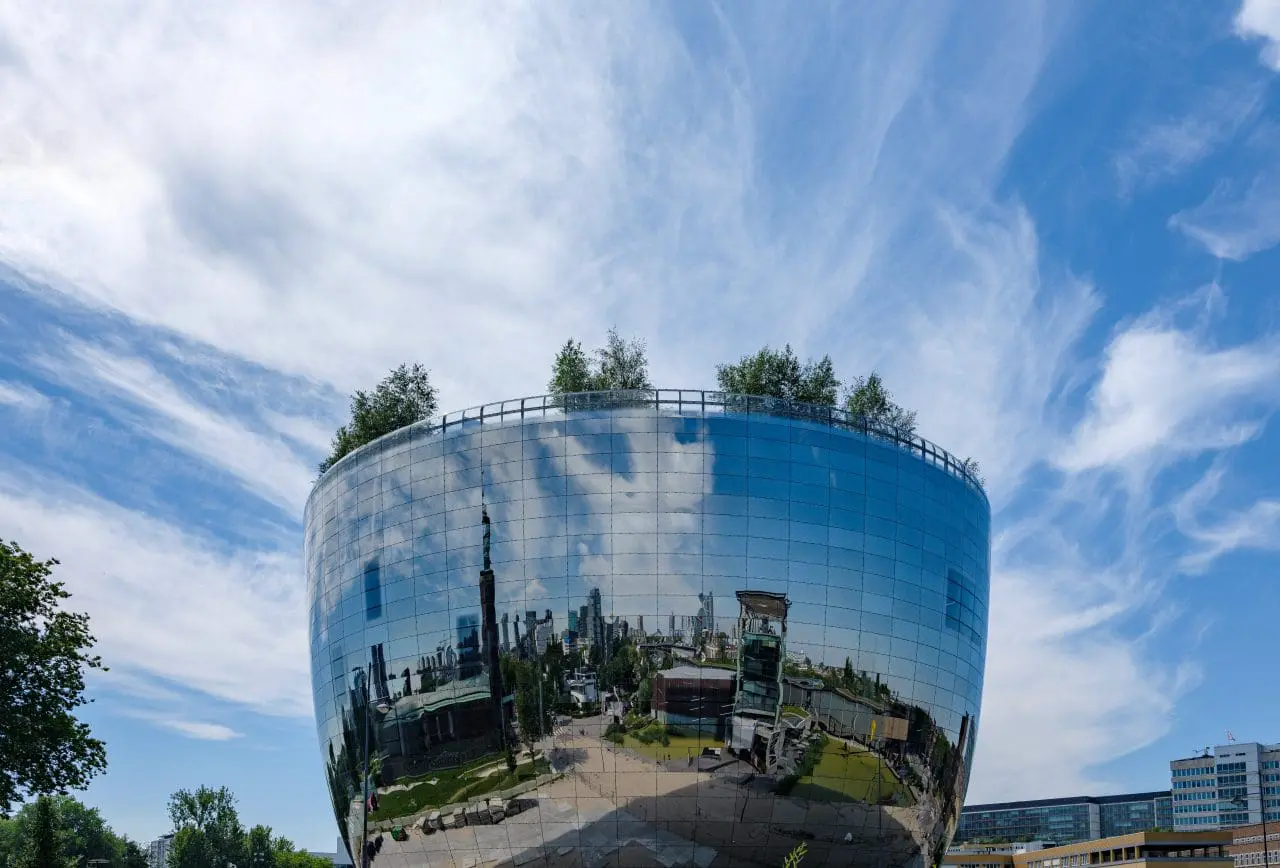

Sustainable building is becoming increasingly important in today’s world, as businesses look to reduce their carbon footprint and create more sustainable practices. Re-usable parts are a great way for companies to reach new levels of sustainability while still maintaining cost-effectiveness. By using re-usable parts in construction projects, businesses can drastically reduce the amount of waste they produce and also save on costs. Dutch architecture firms MVRDV and Madaster have taken sustainable design to new levels by creating a whole office building that’s made of 90 per cent re-usable parts. This is an impressive feat, and it serves as an example of the potential of re-usable parts in construction projects.
Re-usable parts are beneficial for businesses as they can be reused in multiple projects, allowing companies to save money. The most common types of re-usable parts are those made of plastic and metal, such as screws, nails, and other fasteners. These parts can be used again and again in different projects, reducing the need for new materials. Re-usable parts also reduce waste as they are typically recyclable, meaning that instead of being thrown away they can be used over again.
Another benefit is that re-usable parts are often more durable than new materials, meaning they can last longer and require less maintenance over time. This helps businesses save money as they don’t have to replace parts as frequently. Additionally, using re-usable parts can also help companies reduce their carbon footprint, as these items are typically made from recycled materials, which reduces the need for new raw materials.
Re-usable parts offer numerous benefits to businesses that use them in construction projects. These items can help reduce costs, create more sustainable designs, and provide a variety of design possibilities. Additionally, re-usable parts are typically more durable than new materials and require less maintenance over time, making them a cost-effective option for companies looking to save money.
The example set by Dutch architecture firms MVRDV and Madaster of building an office with 90 per cent re-usable parts is a great example of how businesses can utilise these items to their benefit. By using re-usable parts, businesses can reduce their environmental impact while also creating unique designs that stand out from traditional methods.
Re-usable parts are also beneficial for companies as they can be used over and over again in different projects, helping to save money. These items are typically made from recycled materials, meaning that businesses don’t have to use new raw materials every time they need something for a construction project. Re-usable parts are also often more durable than new materials, meaning that they can last longer and require less maintenance over time.
Using re-usable parts in construction projects can be an effective way for businesses to reduce their costs and create more sustainable designs. The example set by MVRDV and Madaster is a testament to the potential of these items, and provides inspiration for other businesses looking to use re-usable parts in their own construction projects.
As more businesses become aware of the benefits of using re-usable parts in construction, it is likely that these items will become increasingly popular. These parts can help companies reduce their carbon footprint while also providing a unique and creative design solution. Additionally, they are typically more durable than new materials, meaning that they can last longer and require less maintenance over time.
One of the biggest benefits of using re-usable parts in construction is that businesses don’t have to use new raw materials every time they need something for a project. This helps reduce waste and save money in the long run. Additionally, re-usable parts can be used over and over again in different projects, helping to reduce costs even further.
The example set by MVRDV and Madaster of creating a whole office building with 90 per cent re-usable parts is an impressive feat and serves as inspiration for other businesses looking to use these items in their own construction projects. As more companies become aware of the potential of re-usable parts, it is likely that they will become increasingly popular in the future.
Re-usable parts are becoming increasingly popular in construction projects, and it’s easy to see why. Not only do they help reduce costs, but they can also create more sustainable designs, improve a project’s long-term durability, and reduce the waste associated with construction projects.
However, it’s important to understand the long-term impacts of using re-usable parts in building projects. These items are typically more durable than regular materials, meaning they can last longer and require less maintenance over time. This helps businesses save money as they don’t have to replace parts as frequently. Additionally, using re-usable parts can also help companies reduce their carbon footprint, as these items are typically made from recycled materials, which reduces the need for new raw materials.
In addition to the environmental benefits of using re-usable parts in construction projects, companies must also consider the potential financial impacts. Re-usable parts are often more expensive than regular materials, but the long-term cost savings can be significant. As these parts are typically more durable, they can last longer and require less maintenance over time, which can add up to significant savings in the long run.
It’s also important for businesses to consider the potential design benefits of using re-usable parts in construction projects. These items offer a variety of design possibilities, and can help create unique projects that stand out from traditional methods. Additionally, using re-usable parts can also help businesses reduce their costs as these items can be used over and over again in different projects.
The example set by Dutch architecture firms MVRDV and Madaster of creating a whole office building with 90 per cent re-usable parts is groundbreaking. The project demonstrates the potential of using innovative techniques to create more sustainable designs. Additionally, it shows how businesses can utilise these items to their benefit by reducing their environmental impact while also creating unique designs that stand out from traditional methods.
The project was also made possible by the collaboration between MVRDV and Madaster, which allowed them to access a variety of re-usable parts from different sources. This enabled them to create an office building that is almost entirely made from re-usable parts, meaning that businesses can reduce their construction costs while creating more sustainable designs.
The success of the MVRDV and Madaster project also shows that businesses can take advantage of re-usable parts to create unique projects. By using these items, companies can reduce their environmental impact while also creating designs that are more visually interesting than those created with traditional materials. Additionally, businesses can use re-usable parts to reduce their costs over time as these items can be used over and over again in different projects.
One of the key benefits of using re-usable parts in construction is the potential cost savings associated with these items. While they may be more expensive than traditional materials, businesses can save money over time as these items are typically more durable and require less maintenance. Additionally, businesses can use re-usable parts over and over again in different projects, which can help reduce their costs even further.
In addition to cost savings, businesses looking to take advantage of re-usable parts should also consider the potential environmental benefits associated with these items. By using recycled materials, companies can reduce their demand for new raw materials, which helps to reduce their environmental impact. Additionally, re-usable parts also help to reduce the amount of waste associated with construction projects as these items can be reused over and over again.
Overall, businesses looking to use re-usable parts in their construction projects should carefully consider the potential cost savings and environmental benefits associated with these items. By taking advantage of these items, companies can reduce their environmental impact while also creating unique designs that stand out from traditional methods. Additionally, businesses can save money over time as re-usable parts are typically more durable and require less maintenance than regular materials.
Dutch architecture firms MVRDV and Madaster have taken sustainable design to new levels by creating a whole office building that’s made of 90 per cent re-usable parts. This groundbreaking project demonstrates the potential of using innovative techniques to create more sustainable designs while also reducing costs over time.
The success of the MVRDV and Madaster project was made possible by their collaboration, which allowed them to access a variety of re-usable parts from different sources. This enabled them to create an office building that is almost entirely made from recycled materials, which helps to reduce the demand for new raw materials while also creating more visually interesting designs than those created with traditional materials.
Additionally, businesses can use re-usable parts to reduce their costs over time as these items can be used again and again in different projects. This helps companies save money as they don’t have to replace parts as frequently. By taking advantage of these items, businesses can reduce their environmental impact while also creating unique designs that stand out from traditional methods.
The groundbreaking example set by Dutch architecture firms MVRDV and Madaster of creating a whole office building with 90 per cent re-usable parts has certainly opened up new possibilities for sustainable building design. By taking advantage of these items, companies can reduce their environmental impact while also creating unique designs that stand out from traditional methods. Additionally, businesses can save money over time as re-usable parts are typically more durable and require less maintenance than regular materials. This demonstrates that businesses looking to create more sustainable designs should consider the potential benefits of using re-usable parts in construction projects.
The use of re-usable parts in building projects is an important step towards creating a more sustainable future. By using recycled materials, businesses can reduce their demand for new raw materials while also reducing the amount of waste associated with construction projects. Additionally, businesses can save money over time as re-usable parts are typically more durable and require less maintenance than regular materials.
Apart from cost savings and environmental benefits, businesses can also use re-usable parts to create unique designs that stand out from traditional methods. By taking advantage of these items, companies can create visually interesting projects while also reducing their overall costs and environmental impact. Additionally, businesses are also able to reduce their costs over time as re-usable parts can be reused multiple times in different projects.
In addition to their cost and environmental savings, businesses should also consider the safety benefits associated with using re-usable parts in construction projects. By taking advantage of these items, companies can ensure that their buildings are safe for occupants as they are made with materials that are designed to last. Additionally, using these items helps to reduce the risk of defects or problems arising due to poor quality materials as they have already been tested and proven to be strong and reliable.
Overall, businesses looking to create more sustainable designs should carefully consider the potential benefits of using re-usable parts in their construction projects. By taking advantage of these items, companies can reduce their environmental impact while also creating unique designs that stand out from traditional methods. Additionally, businesses can save money over time as re-usable parts are typically more durable and require less maintenance than regular materials. This demonstrates the potential of using innovative techniques to create more sustainable designs while also reducing costs over time.


